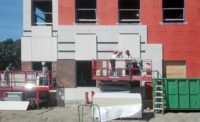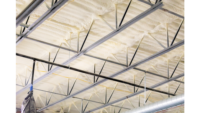Once buzzwords within the building industry, phrases such as “zero net energy,” “sustainable energy,” and “energy conservation,” are now commonplace. In the wake of this new era, building professionals face the challenging task of meeting increasingly stringent energy standards while fulfilling supplemental design goals. Nowhere is this more relevant than the building envelope.
As the physical separator and primary thermal barrier between conditioned and unconditioned spaces, the building envelope directly impacts energy transfer and consumption. According to Better Buildings U.S. Department of Energy, it “plays a key role in determining levels of comfort, natural lighting, ventilation, and how much energy is required to heat and cool a building.”
As building and design professionals well know, the building envelope also impacts factors such as wall thickness, exterior aesthetics and system attachment. Since these elements are often as important as thermal performance, the question becomes: How do building and design teams align form with function? One often unseen hero is rigid foam insulation.
Rigid Foam Insulation and CI
Rigid foam insulation is well-known for its ability to provide thermal resistance in walls, roofs and foundations in both retrofits and new construction. Some of the most common rigid foam insulation options are: Polyisocyanurate (polyiso), expanded polystyrene (EPS) and extruded polystyrene (XPS). With high R-values and an ability to restrict heat transfer, design professionals often use these rigid foam insulations to provide continuous insulation in the building envelope.
As defined in ASHRAE 90.1, Standard for Buildings Except Low-Rise Residential Buildings, CI is “insulation that is continuous across all structural members without thermal bridges other than fasteners and service openings. It is installed on the interior, exterior, or is integral to any opaque surface of the building envelope.”
Since CI helps block pathways for hot or cold air to travel out of the building—preserving energy—it plays a critical role in helping building and design teams deliver comfortable and thermally efficient facilities. In fact, given the effectiveness of CI, it is no longer just a beneficial building envelope design tactic. It is now mandatory in many types of buildings to meet requirements of the International Energy Conservation Codes and ASHRAE 90.1. By 2030, the state of California is calling for all commercial buildings to achieve zero net energy, according to their 2019 Title 24 statewide energy code.
Energy Performance Plus
With the mounting pressure to design buildings within tightened energy standards, rigid foam insulation is in many ways becoming synonymous with CI. Importantly, a growing number of rigid foam insulation products provide a range of supplemental benefits beyond thermal performance, from single attachment points to thinner profiles and fire performance. With proper specification and use, they can do more than satisfy energy codes. To better understand the design and performance freedom these products offer, here’s a look at four ways rigid foam insulation is bridging form and function.
1. Provide thinner profile, higher R-value insulation
To maintain energy code compliance, it is sometimes necessary to increase the CI thickness. This can impact the overall wall assembly design and cause challenges with window and door sizing. Rigid foam insulations with a high R-value help solve this problem, enabling thinner profile, energy compliant wall assemblies, while helping maximize the usable square footage of the building. These materials assist building professionals in achieving design goals without utilizing CI trade-offs through energy modeling.
Consider polyiso, which has a high R-value per inch. Brookwood Elementary School in Leawood, Kan., demonstrates the advantages of this insulation. For the rebuilt school, Kevin Patterson, director of specifications for Hollis + Miller Architects, explains in a recent case study how the design team chose polyiso insulation for its high R-value. It allowed them to create thinner, more cost-effective wall assemblies while also meeting NFPA 285 fire test standards and IECC insulation requirements.
2. Enhance design flexibility
In buildings where a stunning street presence is critical to the success of the overall project, it is crucial to select CI with the necessary design flexibility. Thinner profile rigid foam insulation can help provide architectural relief, as can products with readily alterable depths. Consider the composite rigid foam insulation panels utilized in office complex “706 Giddings Avenue” in West Annapolis, Md.
When developer MRE Properties hired GriD Architects to convert the Class C medical office building to a Class A office, they had a specific goal in mind: to bridge the residential and commercial scales of the building’s neighborhood. A key component of this process was a new façade that reflected the look of nearby residential buildings and paid tribute to Annapolis’ maritime culture. To achieve the desired aesthetic, the firm sought sheathing that could readily alter the depth of the two cladding rainscreens used on the building.
The design team ultimately selected 10,500 square feet of polyiso rigid foam insulation panels, which were available in various thicknesses. The specified product was composed of a closed-cell polyisocyanurate foam core bonded to a premium performance coated glass facer on one side and 5/8- or 3/4-inch fire treated plywood on the other. While out of sight, the panels create an energy-efficient, high-performance envelope that sets the tone for the rest of the building, adding depth and dimension.
3. Simplify attachment while minimizing thermal bridging
Common methods for attaching exterior wall cladding often penetrate the code-required CI layer, providing a thermal bridge. Over the last several years, insulation manufacturers have developed composite products to help reduce this thermal bridging. These products combine rigid foam insulation and wood substrates that make cladding attachment easier and quicker. An example of this is polyiso insulation bonded to plywood or oriented strand board.
In these applications, the entire plywood or OSB surface of the composite panels can be used as a cladding attachment point, eliminating the need for attachment systems such as girts, clips or rails. This greatly simplifies cladding installation while reducing the pathway for heat transfer.
4. Satisfy fire performance requirements
While energy code requirements for CI help solve heat transfer issues, other code compliance requirements must also be considered for commercial buildings. Where codes require non-combustible materials, the challenge design professionals face is specifying wall assemblies in compliance with National Fire Protection Association 285 standards, Standard Fire Test Method for Evaluation of Fire Propagation Characteristics of Exterior Non-Load-Bearing Wall Assemblies Containing Combustible Components.
Today, polyiso, EPS and XPS have all been used in NFPA 285-compliant wall assemblies. However, some products are better-suited for certain types of assemblies than others. Consider advanced polyiso product options, including rigid boards with various facer types, along with thin composite panels. Many of these products have passed NFPA 285 testing within steel-frame, wood-stud, concrete masonry unit, and concrete wall assemblies, with numerous cladding options and weather barriers. They can provide CI and still meet stringent fire test requirements without a significant increase in wall thickness.
EPS and XPS products are also available in a wide range of compositions. It is important to note that EPS and XPS assemblies are limited to non-combustible claddings and may require special detailing to achieve NFPA 285 compliance. For instance, when it comes to window and door header details, these polystyrene foams may require more fire-protective details, such as a steel angle and mineral wool to protect the insulation from flash-over during a fire, than polyiso does. To select the best rigid foam insulation product and ensure individual product compliance questions, consult the manufacturer.
Achieving Design Freedom
Today’s improved rigid foam insulation products have made it possible to tailor CI to specific project goals. While this freedom is advancing building envelope design, it can also increase the risk for misapplication. To ensure rigid foam insulation satisfies individual project goals, involve the manufacturer or supplier early in the design phase. W&C







Report Abusive Comment